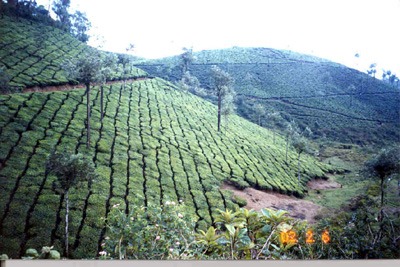Processing of Tea
Growing
Much work is being done in organic and biodynamic farming. Large tea estates have been doing biodynamic farming for some years now. There are Fair Trade certified estates like Makaibary and Ambootia where workers have organized for their community welfare and are paid directly by the Fair Trade organization from the fees received from importers.
Beautifully trimmed tea plantations look like the entire hill sides are carpeted. Tea plantations are called tea gardens and you can see why.
Tea or Carmellia Sinesis, is a hardy, flowering evergreen tree that grows well in tropical and subtropical regions with plenty of rainfall. Young tealeaves, generally the top two leaves with a bud, are picked for processing into tea. If left alone, a tree can grow to 30-40 feet, but cultivated trees are usually pruned to stay at about 3 feet tall, for ease of picking. Shade trees are grown within the rows to provide a shade canopy. Tea trees can live and produce for as long as 100 years. It takes about 3 years for a seedling to mature, then the leaves can be plucked. Women with nimble fingers do most of the plucking. A skilled plucker can, in eight hours, harvest 50,000 stems, which weighs about 75 pounds and produces about 20 lbs. of manufactured tea. Each plant is plucked about every 5 to 7 days depending on the season. The quality of the final product greatly depends on the origin of the plant, soil conditions, altitude, pruning, weeding, fertilizing and rainfall. Tea trees are generally dormant in the wintertime, especially in the cooler, higher altitudes. Spring plucking produces gray-green, glazed appearing leaves and the final processed tea produces light, bright liquor. Summer?s plucking gives purplish bloom and silver tipped leaves and the liquor has a rounded, mellow, and mature taste with more pronounced flavor and color. Monsoon season gives liquor with more color and stronger flavor, often used for breakfast blends. Autumn plucking gives liquor that is lighter with copper/brownish tinge and a delicate, sparkling taste.
White, Green, Oolong and Black Teas
White, green, Oolong and black teas are all produced from the same plant using different processing methods. Fermenting the leaves to give it black color and stronger taste makes black tea. The freshly picked leaves are withered for 18-24 hours by passing dry air over them. This makes the leaves softer and some chemical reactions start taking place. In the orthodox method the leaves then go through machines that twist and break them to release the natural chemicals that react with oxygen during fermentation. In the newer process, called crush, tear and curl (CTC), the leaves are passed through a machine that crushes and breaks the leaves to release the natural chemicals. The leaves are then exposed to the atmosphere to oxidize or ferment. (This produces the dark leaves to get the liquor of strength, color and aroma associated with black tea.) The fermentation is stopped at the desired level by passing the leaves through hot drier- ovens, which reduce the moisture to about 3%. The leaves are then sorted and graded according to size.
White tea is made by plucking only the small, unopened leaf buds. They are then allowed to wither, allowing moisture to evaporate. This tea has a whitish green appearance and produces pale liquor.
Green tea is made by letting the fresh shoots dry for a couple of hours, followed by steaming or heating to stop any fermentation. They are then rolled and dried to produce green tea. China and Japan are the largest producers of green tea.
Oloong tea is made mainly in China and Taiwan. The leaves are processed immediately after plucking. The leaves are first wilted in the sun. Then the edges are brushed to release the natural chemicals from the leaves. The leaves then oxidize, or ferment.
Flavored and Scented Teas
Adding natural or artificial flavoring agents directly to the final tea product makes flavored teas; whereas scented teas are made by keeping the final dried tea in close proximity to natural or artificial aromatics. Teas naturally absorb aromas and pick up the scent of whatever is nearby.
Herb teas of Tinase: They are not teas at all but preparation of herbs.
 Much work is being done in organic and biodynamic farming. Large tea estates have been doing biodynamic farming for some years now. There are Fair Trade certified estates like Makaibary and Ambootia where workers have organized for their community welfare and are paid directly by the Fair Trade organization from the fees received from importers.
Much work is being done in organic and biodynamic farming. Large tea estates have been doing biodynamic farming for some years now. There are Fair Trade certified estates like Makaibary and Ambootia where workers have organized for their community welfare and are paid directly by the Fair Trade organization from the fees received from importers. Beautifully trimmed tea plantations look like the entire hill sides are carpeted. Tea plantations are called tea gardens and you can see why.
Beautifully trimmed tea plantations look like the entire hill sides are carpeted. Tea plantations are called tea gardens and you can see why.

